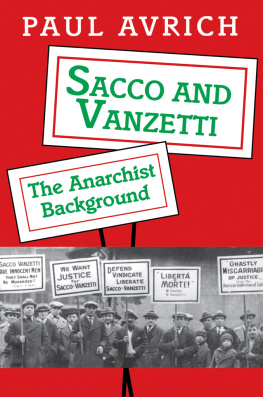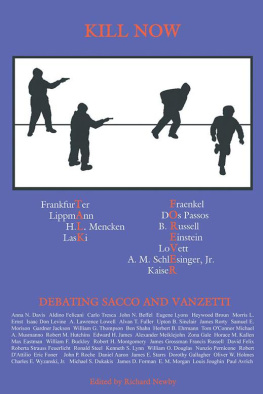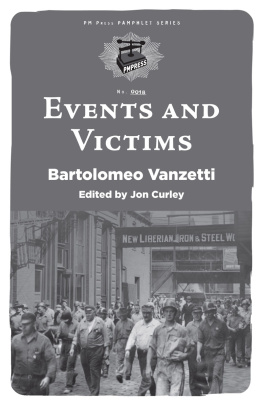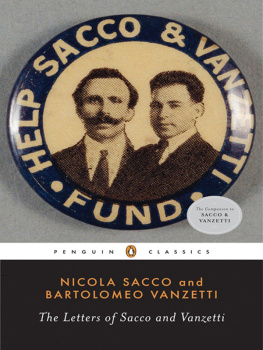Sacco and Vanzetti
Sacco and Vanzetti
THE ANARCHIST BACKGROUND
Paul Avrich
PRINCETON UNIVERSITY PRESS
PRINCETON, NEW JERSEY
Copyright 1991 by Princeton University Press
Published by Princeton University Press, 41 William Street, Princeton, New Jersey 08540
In the United Kingdom: Princeton University Press, Chichester, West Sussex
All Rights Reserved
Library of Congress Cataloging-in-Publication Data
Avrich, Paul
Sacco and Vanzetti: the anarchist background / by Paul Avrich
p. cm.
Includes bibliographical references and index.
ISBN 0-691-04789-8
ISBN 0-691-02604-1 (pbk.)
eISBN: 978-0-691-21620-1
1. Sacco, Nicola. 18911927. 2. Vanzetti, Bartolomeo. 18881927.
3. AnarchistsUnited StatesBiography. 4. AnarchismUnited StatesHistory.
5. Sacco-Vanzetti case. I. Title.
HX843.7.S23A97 1991
364.152309227447dc20
[B] 90-40838
R0
Illustrations
Acknowledgments
THIS BOOK could not have been completed without assistance from so many colleagues and friends that it is impossible to mention them all by name. A few, however, have gone to special lengths in providing me with materials and information, and I owe them particular thanks: Valerio Isca, Professor Nunzio Pernicone, Charles Poggi, and Sebastiano Magliocca, who, though he did not live to see the book in print, was an inestimable source of encouragement and advice.
It has been my good fortune to have spoken to a number of men and women who were personally acquainted with either Sacco or Vanzetti, or both, and who gave me the benefit of their recollections: Beltrando Brini, Gemma Diotalevi, Sara Ehrmann, Joseph Moro, Jenny Paglia, Frank Paradiso, Luigi Paradiso, Ralph Piesco, Bartolomeo Provo, Harry Richal, Fiorina Rossi, the late Art Shields, Concetta Silvestri, and Lefevre Brini Wager.
The following individuals were good enough to place at my disposal documents and photographs that could not be obtained elsewhere: Federico Arcos, Maria Teresa Ciaccio, Herbert and Roberta Feuerlicht, Elisabeth Giansiracusa, Professor David E. Kaiser, Victoria Thompson Murphy, Febo Pomilia, Siphra Rolland, Elide Sanchini, Professor James A. Sandos, Professor James E. Starrs, and George Vaux.
Others who have aided me in important ways are Professor Abraham Ascher, Attilio Bortolotti, Robert S. Calese, Robert DAttilio, Emilio Diotalevi, Jr., Professor Richard Drinnon, Dr. George Esenwein, Oreste Fabrizi, Vincenzo Farulla, Professor Pietro Ferrua, Stewart Freilich, William Gallo, Audrey Goodfriend, Professor George T. Kelley, Aurora Magliocca, Arnold Paglia, Lena Paglia, Paolo Paolini, Maria Rando, Spencer Sacco, Jenny Salemme, Aurora Sallitto, Dominick Sallitto, Edwin Shapiro, Professor Marshall Shatz, Louis Tarabelli, Galileo Tobia, John Vattuone, Stewart Weinstein, and Diva Agostinelli Wieck
I am particularly indebted to Charles Poggi, Professor Nunzio Pernicone, and Professor Richard Polenberg for reading the entire manuscript and offering suggestions by which I have greatly profited. My thanks are due also to Gail Ullman and Alice Calaprice of Princeton University Press for their valuable editorial advice.
The quest for pertinent material has taken me to many libraries and archives, in Europe as well as in America. To the staffs of these institutions, which are indicated in the notes and bibliography, I am much indebted for assistance. I owe special thanks in this regard to the following individuals: Dr. Laura Monti and Dr. Giuseppe Bisaccia of the Boston Public Library; Judith Mellins and Bernice Loss of the Harvard Law School Library; Alice M. Neary and Irma Jackson of the Immigration and Naturalization Service; David G. Paynter of the National Archives; Roger Ritzmann of the New York State Archives; Jennifer Burlis-Freilich of the Missouri State Archives; and Barbara Rivolta of the Paterson Museum.
To the individuals listed above, and to the many others who have helped me in various phases of my work, I tender my heartfelt thanks. My examination of the relevant sources was facilitated by a fellowship from the National Endowment for the Humanities, for which 1 am deeply grateful. The responsibility for this book, however, remains my own.
New York City
August 23, 1990
Sacco and Vanzetti
Introduction
SEVENTY YEARS have passed since the arrest of Nicola Sacco and Bartolomeo Vanzetti, sparking one of the most controversial episodes in American history. On April 15, 1920, a paymaster and his guard were shot to death during a robbery of a shoe factory in South Braintree, Massachusetts. Three weeks later, Sacco, a shoe worker, and Vanzetti, a fish peddler, both Italian immigrants and anarchists, were charged with participating in the crime. The following year they were brought to trial.
According to the prosecution, Sacco did the actual killing (at least of the guard) and Vanzetti was one of four accomplices. The evidence against them was contradictory. On the one hand, a number of witnesses identified them as members of the holdup gang. Both were armed on the night of their arrest, Sacco with a .32-caliber Colt automatic, Vanzetti with a .38-caliber Harrington & Richardson revolver. Both told lies when they were questioned by the police. Their weapons, moreover, seemed to fit the circumstances of the crime, and this weighed heavily against them in the minds of the jurors. On the other hand, both men had substantial alibis, neither had been convicted of any previous crime, and witnesses for the prosecution altered the stories they had told the police and private investigators after the holdup. Furthermore, no information was presented to the jury about the other bandits, who were never apprehended, and the authorities were unable to connect the stolen money, nearly $16,000, with the defendants or their anarchist associates.
The trial, occurring in the wake of the Red Scare, took place in an atmosphere of intense hostility towards the defendants. The district attorney, Frederick G. Katzmann, conducted a highly unscrupulous prosecution, coaching and badgering witnesses, withholding exculpatory evidence from the defense, and perhaps even tampering with physical evidence. A skillful and ruthless cross-examiner, he played on the emotions of the jurors, arousing their deepest prejudices against the accused. Sacco and Vanzetti were armed; they were foreigners, atheists, anarchists. This overclouded all judgment. The judge in the case, Webster Thayer, likewise revealed his bias. Outside the courtroom, during the trial and the appeals which followed, he made remarks that bristled with animosity towards the defendants (Did you see what I did with those anarchistic bastards the other day? I guess that will hold them for a while.) When a verdict of guilty was returned, many believed that the men had been convicted because of their foreign birth and radical beliefs, not on solid evidence of criminal guilt.
In the aftermath of the trial, as legal appeals delayed sentencing, a mounting body of evidence indicated that the wrong men had been apprehended. Key prosecution testimony was retracted and new evidence produced that was favorable to the defendants. Herbert Ehrmann, a junior defense attorney, built a strong case against the Morelli gang of Providence, which specialized in stealing shipments from shoe manufacturers.
All this, however, availed nothing. For the attitude of the authorities had become so rigidly set against the defendants that they turned a deaf ear to contrary views. As a result, a growing number of observers, many of whom abhorred anarchism and had no sympathy with radical propaganda of any kind, concluded that the accused had not received a fair trial. The judges bias against the defendants, their conviction on inconclusive evidence, their dignified behavior while their lives hung in the balanceall this attracted supporters, who labored to secure a new trial. At the eleventh hour, Governor Alvan T. Fuller conducted a review of the case, appointing an advisory committee, headed by President A. Lawrence Lowell of Harvard, to assist him. The Lowell Committee, as it became known, though finding Judge Thayer guilty of a grave breach of official decorum in his derogatory references to the defendants, nevertheless concluded that justice had been done.










